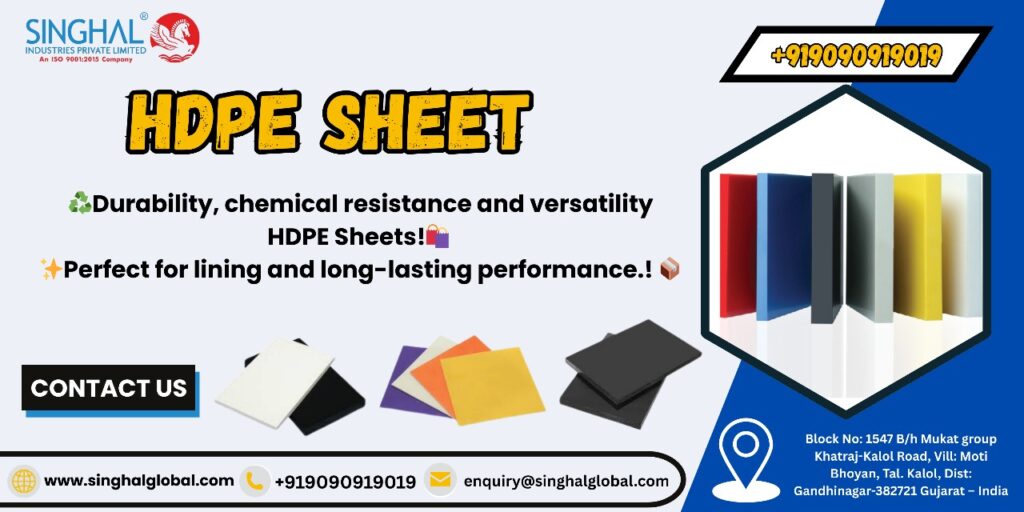Walk into any modern food processing plant, and you’ll notice one thing immediately—everything must be spotless, durable, and built to handle stress. From the chopping tables of meat factories to the packaging area in dairy facilities, cleanliness is an absolute requirement. However, behind the polished surfaces and rigorous quality inspections is a substance that frequently isn’t noticed: HDPE Sheets.
These flexible sheets of plastic have revolutionized the way food companies design spaces, create equipment, and keep up with the highest standards of safety. No matter whether you’re looking at HDPE sheets 4×8 to make cutting boards, or huge rolls to line storage areas, they are now the foundation in modern and food-safe spaces.
Why HDPE Sheets Are a Game-Changer for Food Processing
Any contamination, even the smallest, can harm a brand’s reputation and even put the safety of consumers in danger. Food facilities’ materials should be strong, simple to clean, and impervious to bacteria, moisture, and chemicals. The smooth, non-porous coating guarantees that fungi and bacteria do not create breeding grounds.
A manager of a food manufacturing facility in Gujarat once said to me, “We changed from cutting tables to sheets of HDPE about two years ago. The hygiene was improved, not only that but the boards also lasted much longer.” These real-life tales like this show the reasons HDPE is now the preferred material for the industry.
The Durability Factor
Food processing is not gentle work. The weight of the equipment, sharp knives, and continuous cleaning routines put huge pressure on the materials. HDPE sheets makers in India have perfected the art of creating sheets that can withstand all this without breaking or losing their strength. Their inherent toughness enables them to stand up to impacts with high pressure, as well as repeated usage. Imagine a factory bakery where tools and trays are thrown on tables for preparation many times per day. HDPE sheets won’t give up. They’re also unlike steel; they aren’t affected by rust, which makes them ideal for moist environments like seafood processing units.
Hygiene Above All
In the food industry, hygiene isn’t just a top priority; it’s also a legal requirement. International as well as Indian safety standards have surfaces that are resistant to the growth of bacteria, and HDPE meets the requirements perfectly. Clean and easy to clean: a quick wipe or rinse and you’re good to go. Chemical resistant: resists disinfectants and does not degrade. If you compare it to wood, which is a sponge for liquids, or even metal, which is susceptible to corrosion, HDPE’s purity is a distinct feature. A lot of HDPE sheets manufacturers in India market their products as “food grade,” meeting FDA or comparable safety standards.
Applications of HDPE Sheets in Food Processing
- Working surfaces, cutting boards safe for direct exposure to food.
- Containers and storage bins – lightweight and hygienic to transport materials that have been processed or made raw.
- Flooring and walls protect from spills and create cleanliness in the environment.
- Packaging – made of sheets and rolls to wrap food items.
- Conveyor systems – a durable, low-friction surface.
In India, there are many dairy farms that depend on HDPE sheets 4×8 for workstations. Meanwhile, meat processors make use of custom-cut boards that have been cut to the size required.
Balancing Cost and Quality
Let’s discuss the money. Food companies typically weigh the price of their materials versus their longevity. It is quite possible that people think that HDPE costs more than wood alternatives at first sight. However, here’s the truth:
- Longer lifespan means fewer replacements.
- Less hygiene concerns can prevent loss due to contamination.
One of the Hdpe sheets Suppliers units at Delhi informed how its monthly expenses went down after it switched to HDPE preparation boards. They did not have to change wooden boards damaged by regular cleaning. Although on a short term, it might seem more costly, it will worth it in the long run.
Real-Life Perspective: A Chef’s View
Not only big factories gain. Restaurants and professional kitchens are using HDPE boards. A chef I know from Mumbai is a fan: “Wooden boards look rustic; however, in commercial kitchens, it’s safer than appearances. HDPE provides me with confidence knowing that the food I prepare is secure.” This combination of hygiene and convenience proves why HDPE is no longer serving only the industrial market at the moment but is gradually making its way into every-day kitchens.
Environmental Angle
There are a lot of differing opinions. HDPE is a plastic material, which means many people consider it an environmental problem. But let’s not make it too easy. HDPE is recyclable, unlike the majority of plastics that are used for one-time use. A lot of HDPE sheets producers now provide recycled versions that function similarly. The most important question is: should food companies make use of a material that lasts for many years and is recyclable, or opt for more disposable and less durable alternatives that produce more waste? Personally, I believe HDPE is a more sustainable choice over the long term.
Conclusion
As demanding and rapid as the food processing industry is, products need to be quality, durable and effective. Epoxy DPE sheets fit the criteria They are also impervious to chemicals, water, and shocks and thus HDPE sheet makes a good material of cut-boards, container storage materials, wall linings among others. There are those who doubt whether plastic is the best option to be sustainable. When you weigh safety, quality, durability, and recycling, HDPE emerges as a clear winner. When you next take a bite of a well-packaged snack or look at an incredibly clean kitchen counter, there’s an excellent chance HDPE sheets are quietly working in the background, ensuring businesses are safe and food items are running efficiently.
FAQs
Q1. Are HDPE sheets suitable for use in marine applications?
HDPE has water resistance and is not corrosive, making it ideal for seafood processing and marine applications.
Q2. Are HDPE sheets simple to drill into?
Absolutely. Although they are tough, they can be cut, drilled, or shaped to accommodate custom-made applications without compromising their integrity.
Q3. Does HDPE fall into the environmentally viable category?
HDPE as a material can be recycled, using it over long periods without the necessity of replacing it frequently and lessening other production waste.
Q4. How thick is average HDPE sheet?
The typical thickness ranges from 3mm to 25mm. However, custom sizes are offered based on the needs of the customer.
Q5. Who is the largest manufacturer of HDPE sheets?
India has some of the leading HDPE sheets manufacturers that have both local and external consumers. The HDPE sheets suppliers are diverse; nevertheless, Gujarat and Delhi can be viewed as the main sources of high-quality, food grade HDPE sheets.









